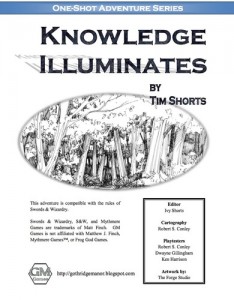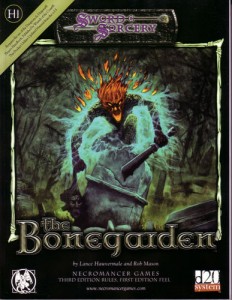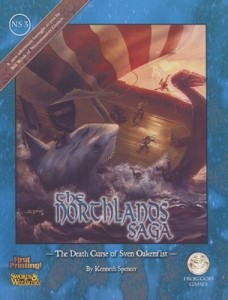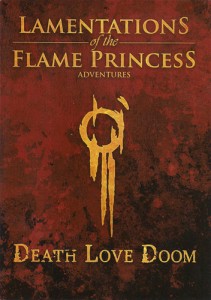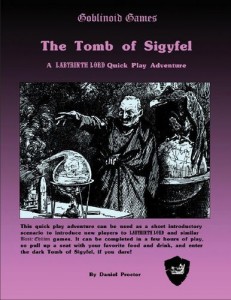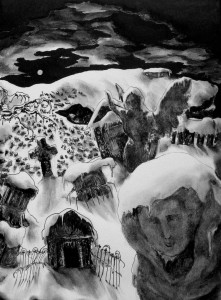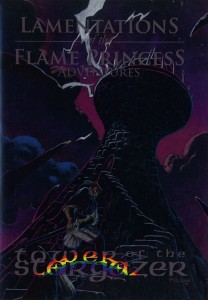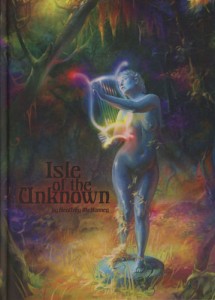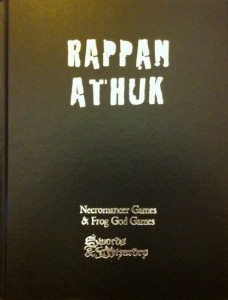
Frog God Games
Swords & Wizardry
Levels 1-20
[The new Kickstarter version]
It’s really big. It’s really tough. It’s got a TON of interesting encounters and levels. It’s also maddeningly confusing in places and shows a 3e heritage. It’s WELL worth having and playing.
Uh … yeah … so this thing is BIG. Something like 55 levels, plus the ground level, plus the wilderness areas … and THEN they are going to release more levels for it in the future. The book is about 500 pages long and the text to describe just the dungeon levels is about 325 pages long, not counting the ground levels and the wilderness areas. And thats for the Swords & Wizardry version; I shudder to think how long the Pathfinder version is! [Hmmm, rpggeek.com says 673. Not bad for stat bloat!] I spent two weeks reading and read all of the wilderness and dungeon levels twice, thumbing through the appendices and the supplemental books. With some restocking rules in play I’m pretty sure you could run this module forever.
The way the levels are interconnected in the adventure is second to none. There are AT LEAST seventeen different entrances to the dungeon from the surface. Levels are interconnected with stairs, slides, pits, tunnels, streams, and teleporters. Levels and sublevels connect horizontally and vertically. Some interconnections skip many levels, and in one case that’s “9 levels deeper.” Level 1B (EL 4) can drop you to level 10B (EL9.) Depth underground as an indicator for toughness? Level 3B is EL 17+, although admittedly it’s impossible to get to without being close to that experience level and having explore a massive part of Rappan Athuk. This is absolutely WONDERFUL. The depth underground, hidden levels, and bypassing areas only to return later recall the very best of the level design from Thracia. It is wonderful to see and appears to flow much more organically than the interconnects in Stonehell.
The various levels have a lot of individuality to them. This has a great del to do with the level design and the encounters on the levels. Many, if not most, of the rooms with encounters feel more like set pieces than Just Another Encounter. I don’t mean a railroad encounter but rather an encounter with some crazy and unusual shit going on. In addition the encounters and rooms cover just about every classic element possible. A vampire & succubus lover, with the succubus used better than I’ve ever seen another. Sucking mud, poison air and Will-o-Wisps. A basilisk? No. A cavern FULL of basilisks. Goblin cities. Jungle levels. A level with multiple mazes that are used very, very well. There’s just so much here that it’s actually hard to pick something out. Let’s pick one completely at random. A room full of rubble from a collapsed ceiling. Move is halved. Running requires a saving throw or you fall and take a bit of damage. There’s a narrow passage near the ceiling that you can find with a locate secret doors check. Wandering monsters like to hang out at this point on the other side. That is a great room on many levels. Best of all it shows how the simple mechanics of 0e D&D can be used to great effect. Let’s pick another: a room full of statues that must be rotated to cause a secret door to open. And another: a room full of hot quicksand with an arched bridge of it and the ceiling full of hot sulfuric gasses. Not every room is this way … but it sure as hell seems that way … AND I LIKE IT! It reminds me a lot of the Tower of Gygax. It’s not. As I said there are many rooms that are empty or trivial. But it reminds me of it and that’s certainly the impression I got after reading the thing. The kind of slow deliberate exploration with many puzzle-like (but no riddle) elements in each room makes each place seem dangerous and mysterious. That’s just the kind of feeling I’m looking to invoke in my players.
I’d like to cover a few things that are … problems? with Rappan Athuk. First, the one thing that really pissed me off: There are monsters pulled from other books that don’t have full entries in the bestiary section. A decent number, 60 to be exact, are pulled from Tomb of Horrors Complete. Uncool guys. The mini-stat block is included at the rooms entry where they are found but all of the creatures special abilities, etc, are not. Uncool. Yeah, I know I had to have Fiend Folio or MM2 if those monsters were referenced by T$R in a product. That was bullshit also. UN. COOL.
The book is also unwieldy because the dungeon is so large. The book proper, is going to be fun to manage at the game table with it’s whole 500 pages, but I’m more speaking of the lack of a useful introduction/overview. The book does have an introduction and it does have an overview and each level has a little section that it essentially an overview of that level, noting special effects, rules, and a little background on the level. The introduction and overview for the entire dungeon, though, is not useful. Essentially we learn that the followers of Orcus live there and adventurers like to go there. There is a side-view map provided that shows all of the levels and their interconnections, along with the room number of the interconnection that helps a little but it’s not enough. Maybe some color-coding on the side-view to show areas of influence and some notations of equivalent dungeon level? And perhaps a slightly longer dungeon overview that notes the various factions in the dungeon and how the various levels fit together. That’s the root of the problem: with a product this big it’s very hard to get the big picture view from reading through the module levels. After two read throughs I’m still not sure how all of levels fit together. There’s also a decent amount of foreshadowing missing. Many of the levels and encounters would be better if the party learned about them ahead of time. Fearful mumblings of prisoners or some such. There IS a decent rumor table but I think the levels could have worked out better if there was some knowledge of things to come. Certainly a DM can insert this themselves, however the general obfuscation-due-to-size thing comes in to play here as well.
This extends to the wilderness area above. There IS a wilderness area provided along with suggestions on how to use them in play. (Ambushes as you come out of the dungeon, anyone?) It’s got an extensive number of encounters, numerous groups of bandits, and a robust and diverse description of the various environments in the area. What it doesn’t have is a decent key or layout. Just a map with some numbers on it. There’s a road on the map … but the only settlement mentioned is WAY off the road. Like, 40 miles off the road. A riverboat stop.??? It SEEMS like there should be another settlement closer. I get that feeling from a lot of the text in the module, but there doesn’t appear to be any. It’s gonna be a long hike back from the dungeon. 1/2″ =10miles and the map fills an entire 8.5×11 page, with the main/killer dungeon entrance roughly in the center. That’s gonna be roughly 100 mile hike down the coast road to a settlement IF it’s right on the edge of the map. It feels wrong, as if I’ve missed something. It seems like there should be more in the way of how the surface works together and the logistics of exploring the dungeon.
Factions are an issue as well. I’m STILL not sure if there are any factions in this thing. There are a couple of NPC’s who are noted as not being intent on immediate murder. A handful more are described ambiguously enough that you could insert some role-playing. (IE: The guy is not described as attacking on sight.) The single exception may be the goblin city, in which there is a faction-like thing going on that clearly recognizable. This is a bit relentless for my tastes, especially for such a large dungeon.
The encounters do tend to be more verbose than I’d prefer. It’s not quite at 3e “pay per cent” levels but it does clearly have a mild case of the verbosity sickness. WAY too many words are used to describe many rooms which impairs the DM’s ability to quickly look at the room description and figure out what’s going on. Some serious editing could have been used to pare things down. Again, it’s not quite at 3e levels, there are still ten or so encounters to a page, but it’s pretty damn close.
Finally, most levels are smaller than I think many folks first imagine. The vast majority of the levels look like something out of the 3e era. Maybe 16 or so rooms per level and a loop or two. NOT linear, but not quite the ‘fill the page’ type design either. This is mitigated to a certain extent by the NUMEROUS interconnections between most levels, allowing the vertical to come in to play as well, but the individual levels still seems weird and feels small.
The battle maps are stupid and not worth having. They are just some almost generic thing. Same for the pre-gens. You’re getting nothing special there.
None of that, though, is a deal breaker. What it means is that the DM is going to have to put some time in to understand the module, crib it with notes in places, and develop a logistics plans around the entry/exits.
You can get this on DriveThru.
https://www.drivethrurpg.com/product/112605/Rappan-Athuk–Swords-and-Wizardry-Edition?affiliate_id=1892600

